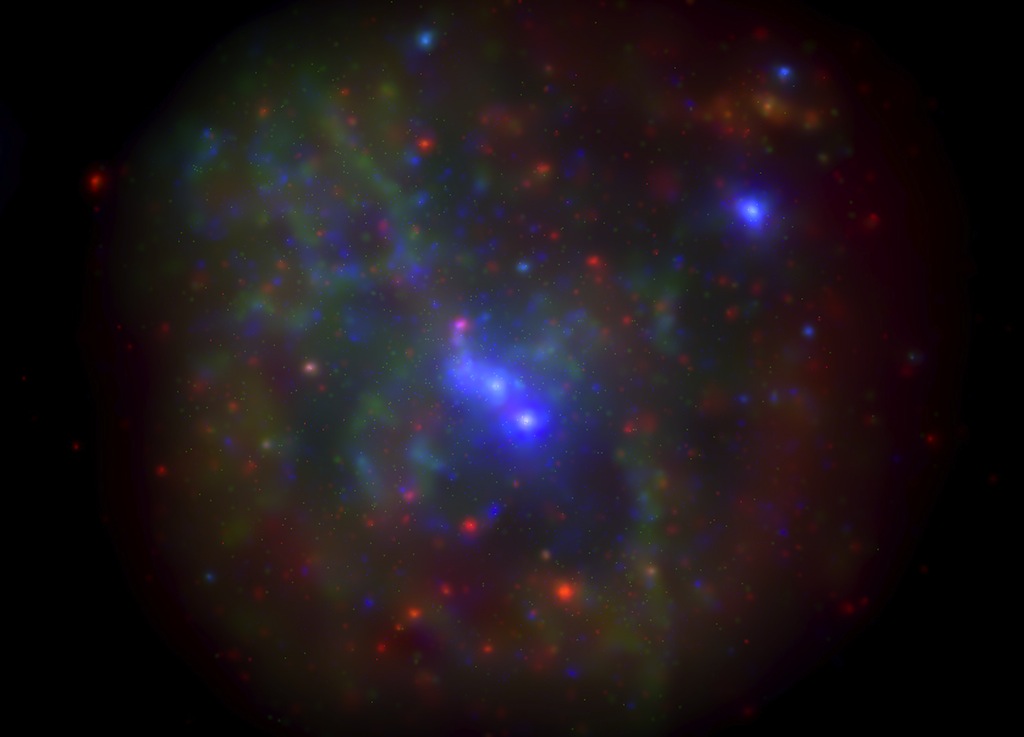Milky Way's Huge Black Hole to Gobble Gas Cloud Soon

A giant gas cloud is set to spiral into the supermassive black hole at the Milky Way's core in the next few months, and scientists should get a great view of the dramatic celestial action.
NASA's Swift satellite will have a front-row seat for the enormous gas cloud collision, and astronomers can barely contain their excitement.
"Everyone wants to see the event happening because it's so rare," Nathalie Degenaar, of the University of Michigan, said in a statement. [Milky Way's Black Hole Eats Gas Cloud (Images)]
Collision coming
In 2003, scientists discovered what seemed to be a cloud of gas, termed G2, which should collide in March or thereabouts with the supermassive black hole that lurks at the heart of the Milky Way. The interaction will reveal much about this black hole, which is known as Sagittarius A* (or Sag A* for short).
Although scientists have observed signs of such feeding in other galaxies, it's rare to see these events so close to home.
With their enormous gravitational pull, the centers of black holes trap even light, making them difficult to see. But the edges of these odd objects light up up when they feed, emitting energy that can reveal details about black-hole dynamics.
Breaking space news, the latest updates on rocket launches, skywatching events and more!
Sag A* is dim even for a class of object known to be challenging to observe —almost 4,000 times fainter than astronomers expect it to be. Every 5 to 10 days, the hungry black hole gobbles down a bit of gas or dust that creates an X-ray flare that telescopes like Swift can capture.
For the last eight years, Degenaar and her team have used Swift to observe the galactic center for 17 minutes a day. On the whole, it’s been fairly quiet.
"Our supermassive black hole is laying low," Degenaar told reporters earlier this month. "It’s not displaying a lot of action at all."
That may well change when G2 crashes into Sag A*, since the interaction could create an X-ray flare brighter than those generated by smaller objects. Degenaar’s team, still monitoring Sag A* every day, will be in a perfect position to observe the changes, and other instruments will try to get a good look as well.
"Observatories all over the world, space- and ground-based, are ready for this," Degenaar said.
A hidden star
While many astronomers describe G2 as a large cloud about a dozen times more massive than Earth, it could also be a smaller cloud hiding a star at its center, researchers say.
For example, the cloud could contain a variable star known as a T Tauri. But the star would likely be too faint for astronomers to detect.
"You [could] have a windy star plowing through the interstellar medium," Leo Meyer of UCLA told reporters earlier this month.
It's also possible that G2 contains a protoplanetary disk disrupted by tidal forces. The building of planets so close to the galactic center could inform theories of planet formation. However, such a source should have brightened more than scientists have observed.
A third option involves the product of a merged binary. At this point, astronomers aren't sure which is the likeliest scenario.
"There is no smoking gun measurement that clearly tells us whether it is this or that," Meyer said.
Fireworks or dud?
When G2 gets within about 200 astronomical units of Sag A*, it should start to feel strong gravitational effects. (One astronomical unit is the distance between Earth and the sun — about 93 million miles, or 150 million kilometers).
But how dramatic those effects will be is still up in the air.
"The biggest question probably is, Will there be fireworks or not?" Meyer said. "We still don’t know."
"Fireworks" would involve the black hole brightening considerably as a significant amount of mass is dumped into it. Though he hopes for it, Meyer thinks an explosive show is unlikely.
But even if the fireworks don't materialize, he doesn’t think the focus on the galactic center will be a loss. The resulting data should still reveal some information about the workings of Sag A*. And the last few years have produced a spike in theoretical discussions on how black holes interact with incoming material.
"Even if nothing happens, this has triggered a whole lot of thinking," Meyer said.
Follow us @Spacedotcom, Facebook and Google+. Original article on SPACE.com.
Join our Space Forums to keep talking space on the latest missions, night sky and more! And if you have a news tip, correction or comment, let us know at: community@space.com.

Nola Taylor Tillman is a contributing writer for Space.com. She loves all things space and astronomy-related, and always wants to learn more. She has a Bachelor's degree in English and Astrophysics from Agnes Scott College and served as an intern at Sky & Telescope magazine. She loves to speak to groups on astronomy-related subjects. She lives with her husband in Atlanta, Georgia. Follow her on Bluesky at @astrowriter.social.bluesky
![Black holes are strange regions where gravity is strong enough to bend light, warp space and distort time. [See how black holes work in this SPACE.com infographic.]](https://cdn.mos.cms.futurecdn.net/8GbuLi8DVtx8HoZeSyndT7.jpg)

